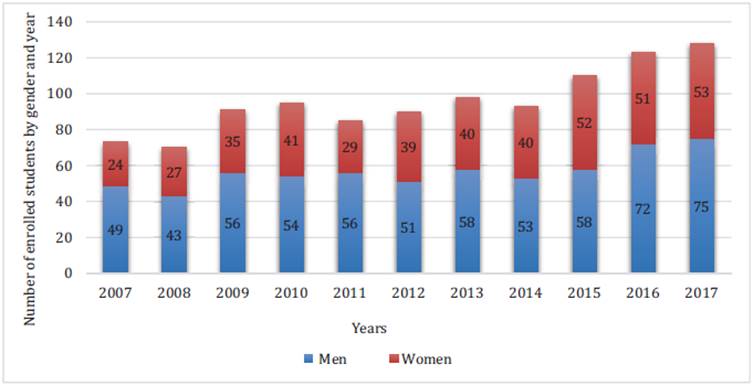Letter to the editor
Gender gap in anesthesiology in Colombia
Marian Rincón-Montañaa
María Paula Bernal-Vargasb
Diego Rossellia
*
a Department of Clinical Epidemiology and Biostatistics, Pontificia Universidad Javeriana, Bogota, Colombia.
b School of Medicine, Universidad Nacional de Colombia, Bogota, Colombia.
A group discussion was held during the XXXIII Colombian Congress of Anesthesiology under the title of "Women as pioneers and leaders in anesthesiology" in which the topic of discussion was the gender gap and its social and cultural backdrop.1 Based on the National Higher Education Information System we reviewed the number of enrolled students, by gender, in the 21 programs available in the country for the period between 2007 and 2017 (Fig. 1). During the first 3 years of this analysis (2007-2009), 86 women were enrolled (37%), while the number increased to 156 (43%) during the last 3 years, suggesting a reduction in the gap. The study by Rosselli et al2 mentions a proportion of 24% of women trained as anesthetists during the 1990 to 1999 decade.
Although there is a gender gap in other specialties,3 with the growing numbers of women attending medical school, this gap is shrinking in specialized medicine. In Colombia, as in the United States,4 the gender gap, at least in anesthesiology, will soon be a thing of the past.
References
1. Caicedo-Salazar J. Diferencias de género en anestesia. Conversatorio: Las mujeres como pioneras y lideresas de la anestesiología. XXXIII Congreso Colombiano de Anestesiología y Reanimación. Sociedad Colombiana de Anestesiología y Reanimación. Bucaramanga, Colombia. 2019.
[ Links ]
2. Rosselli D, Otero A, Heller D, et al. La medicina especializada en Colombia: una aproximación diagnostica. Bogotá: Centro Editorial Javeriano; 2000.
[ Links ]
3. Botero-Rodríguez F, Pantoja C. The gender gap in Acta Neurológica Colombiana. Acta Neurol Colomb 2018;34:257-258.
[ Links ]
4. De Oliveira GS, Akikwala T, Kendall MC, et al. Factors affecting admission to anesthesiology residency in the United States: choosing the future of our specialty. Anesthesiology 2012;117: 243-251.
[ Links ]











 text in
text in 



